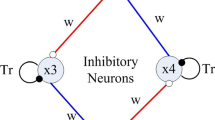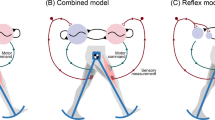Abstract
Are there general principles for pattern generation? We examined this question by analyzing the operation of large populations of evolved model central pattern generators (CPGs) for walking. Three populations of model CPGs were evolved, containing three, four, or five neurons. We identified six general principles. First, locomotion performance increased with the number of interneurons. Second, the top 10 three-, four-, and five-neuron CPGs could be decomposed into dynamical modules, an abstract description developed in a companion article. Third, these dynamical modules were multistable: they could be switched between multiple stable output configurations. Fourth, the rhythmic pattern generated by a CPG could be understood as a closed chain of successive destabilizations of one dynamical module by another. A combinatorial analysis enumerated the possible dynamical modular structures. Fifth, one-dimensional modules were frequently observed and, in some cases, could be assigned specific functional roles. Finally, dynamic dynamical modules, in which the modular structure itself changed over one cycle, were frequently observed. The existence of these general principles despite significant variability in both patterns of connectivity and neural parameters was explained by degeneracy in the maps from neural parameters to neural dynamics to behavior to fitness. An analysis of the biomechanical properties of the model body was essential for relating neural activity to behavior. Our studies of evolved model circuits suggest that, in the absence of other constraints, there is no compelling reason to expect neural circuits to be functionally decomposable as the number of interneurons increase. Analyzing idealized model pattern generators may be an effective methodology for gaining insights into the operation of biological pattern generators.
Similar content being viewed by others
References
Alberts B, Bray D, Lewis J, Raff M, Roberts K, Watson JD (1989) Molecular Biology of the Cell (2nd ed.). Garland, New York.
Alexander RM (1992) Exploring Biomechanics: Animals in Motion. Freeman.
Arshavsky YI, Orlovsky GN, Panchin YV, Roberts A, Soffe SR (1993) Neuronal control of swimming locomotion: Analysis of the pteropod mollusc Clione and embryos of the amphibian Xenopus. Trends Neurosci. 16: 227–233.
Beer RD (1990) Intelligence as Adaptive Behavior: An Experiment in Computational Neuroethology. Academic Press, San Diego, CA.
Beer RD (1995) A dynamical systems perspective on agentenvironment interaction. Artificial Intell. 72: 173–215.
Beer RD (1997) The dynamics of adaptive behavior: A research program. Robot. Autonom. Sys. 20: 257–289.
Beer RD, Gallagher JC (1992) Evolving dynamical neural networks for adaptive behavior. Adaptive Behavior 1(1): 91–122.
Brezina V, Weiss KR (1997) Analyzing the functional consequences of transmitter complexity. Trends Neurosci. 20: 538–543.
Calabrese RL (1998) Cellular, synaptic, network, and modulatory mechanisms involved in rhythm generation. Curr. Opin. Neurobiol. 8: 710–717.
Calabrese RL, Nadim F, Olsen OH (1995) Heartbeat control in the medicinal leech: A model system for understanding the origin, coordination, and modulation of rhythmic motor patterns. J. Neurobiol. 27: 390–402.
Chiel HJ, Beer RD (1997) The brain has a body: Adaptive behavior emerges from interactions of nervous system, body and environment. Trends Neurosci. 20: 553–557.
Chiel HJ, Beer RD, Gallagher JC (1999) Evolution and analysis of model CPGs for walking I. Dynamical modules. This issue.
Cliff D (1991) Computational neuroethology: A provisional manifesto. In: Meyer J-A, Wilson SW, eds. From Animals to Animats: Proceedings of the First International Conference on Simulation of Adaptive Behavior. MIT Press, Cambridge, MA. pp. 29–39.
Cohen AH (1992) The role of heterarchical control in the evolution of central pattern generators. Brain Behav. Evol. 40: 112–124.
Dumont JPC, Robertson RM (1986) Neuronal circuits: An evolutionary perspective. Science 233: 849–853.
Elliott CJH, Benjamin PR (1985a) Interactions of pattern-generating interneurons controlling feeding in Lymanaea stagnalis. J. Neurophysiol. 54: 1396–1411.
Elliott CJH, Benjamin PR (1985b) Interactions of the slow oscillator interneuron with feeding pattern-generating interneurons in Lymnaea stagnalis. J. Neurophysiol. 54: 1412–1421.
Friesen WO (1989) Neuronal control of leech swimmingmovements. II. Motor neuron feedback to oscillator cells 115 and 28. J. Comp. Physiol. A 166: 205–215.
Gardner D (1993) Static determinants of synaptic strength. In: Gardner D, ed. The Neurobiology of Neural Networks, MIT Press, Cambridge, MA. pp. 21–70.
Getting P (1989) Emerging principles governing the operation of neural networks. Ann. Rev. Neurosci. 12: 185–204.
Getting PA, Dekin MS (1985) Tritonia swimming: A model system for integration within rhythmic motor systems. In: Selverston AI, ed. Model Neural Networks and Behavior. Plenum, New York. pp. 3–20.
Goldberg DE (1989) Genetic Algorithms in Search, Optimization and Machine Learning. Addison-Wesley, Reading, MA.
Grillner S, Deliagina T, Ekeberg O, el Manira A, Hill RH, Lansner A (1995) Neural networks that co-ordinate locomotion and body orientation in lamprey. Trends Neurosci. 18: 270–279.
Harris-Warrick RM, Marder E, Selverston AI, Moulins M (1992) Dynamic Biological Networks: The Stomatogastric Nervous System. MIT Press, Cambridge, MA.
Hurwitz I, Kupfermann I, Susswein AJ (1997) Different roles of neurons B63 and B34 that are active during the protraction phase of buccal motor programs in Aplysia californica. J. Neurophysiol. 75: 1327–1344.
Hurwitz I, Neustadter D, Morton DW, Chiel HJ, Susswein AJ (1996) Activity patterns of the B31/B32 pattern initiators innervating the I2 muscle of the buccal mass during normal feeding movements in Aplysia californica. J. Neurophysiol. 75: 1309–1326.
Hurwitz I, Susswein AJ (1996) B64, a newly identified central pattern generator element producing a phase switch from protraction to retraction in buccal motor programs of Aplysia californica. J. Neurophysiol. 75: 1327–1344.
Kater SB (1974) Feeding in Helisoma trivolvis: The morphological and physiological bases of a fixed action pattern. Am. Zool. 14: 1017–1036.
Katz PS, Tazaki K (1992) Comparative and evolutionary aspects of the crustacean stomatogastric system. In: Harris-Warrick RM, Marder E, Selverston AI, Moulins M, eds. Dynamic Biological Networks: The Stomatogastric Nervous System. MIT Press, Cambridge, MA. pp. 221–261.
Kiehn O, Eken T (1998) Functional role of plateau potentials in vertebrate motor neurons. Curr. Opin. Neurobiol. 8: 746–752.
Kristan WB Jr, Skalak R, Wilson RJA, Skierczynski BA, Murray JA, Eisenhart FJ, Cacciatore TW (In press). Biomechanics of hydroskeletons: Lessons learned from studies of crawling in the medicinal leech. In: Winters JM, Crago PE, eds. Biomechanics and Neural Control of Movement. Springer-Verlag, New York.
Kupfermann I, Deodhar D, Rosen SR, Weiss KR (1993) The use of genetic algorithms to explore neural mechanisms that optimize rhythmic behaviors: Quasi-realistic models of feeding behavior in Aplysia. In: Eeckman FH, Bower JM, eds. Computation and Neural Systems. Kluwer, Boston, MA. pp. 295–300.
Lockery SR, Sejnowski TJ (1992) Distributed processing of sensory information in the leech. III. A dynamical neural network model of the local bending reflex. J. Neurosci. 12(10): 3877–3895.
Marder E, Abbott LF (1995) Theory in motion. Curr. Opinion Neurobiol. 5: 832–840.
Marder E, Calabrese RL (1996) Principles of rhythmic motor pattern generation. Physiol. Rev. 76: 687–717.
Marder E, Selverston AI (1992) Modeling the stomatogastric nervous system. In: Harris-Warrick RM, Marder E, Selverston AI, Moulins M, eds. Dynamic Biological Networks: The Stomatogastric Nervous System. MIT Press, Cambridge, MA. pp. 161–196.
Mitchell M (1996) An Introduction to Genetic Algorithms. MIT Press, Cambridge, MA.
Moody SL, Wise SP, di Pellegrino G, Zisper D (1998) A model that accounts for activity in primate frontal cortex during a delayed matching-to-sample task. J. Neurosci. 18(1): 399–410.
Pearson KG (1981) Interneurones and locomotion. Trends Neurosci. 4: 128–131.
Pearson KG (1993) Common principles of motor control in vertebrates and invertebrates. Annu. Rev. Neurosci. 16: 265–297.
Robertson GA, Mortin LI, Keifer J, Stein PS (1985) Three forms of the scratch reflex in the spinal turtle: Central generation of motor patterns. J. Neurophysiol. 53: 1517–1534.
Selverston AI (1980) Are central pattern generators understandable? Behav. Brain Sci. 3: 535–571.
Turrigiano G, LeMasson G, Marder E (1995) Selective regulation of current densities underlies spontaneous changes in the activity of cultured neurons. J. Neurosci. 15: 3640–3652.
Turvey MT (1990) Coordination. American Psychologist 45(8): 938–953.
Weimann JM, Meyrand P, Marder E (1991) Neurons that form multiple pattern generators: Identification and multiple activity patterns of gastric/pyloric neurons in the crab stomatogastric system. J. Neurophysiol. 65: 111–122.
Williams TL, Bowtell G, Carling JC, Sigvardt KA, Curtin NA (1995) Interactions between muscle activation, body curvature and the water in the swimming lamprey. Symp. Soc. Exp. Biol. 49: 49–59.
Wolfram S (1996) The Mathematica Book (3rd ed.). Cambridge University Press, Cambridge.
Wright WG, Kirschman D, Rozen D, Maynard B (1996) Phylogenetic analysis of learning-related neuromodulation in molluscan mechanosensory neurons. Evolution 50: 2248–2263.
Author information
Authors and Affiliations
Rights and permissions
About this article
Cite this article
Beer, R.D., Chiel, H.J. & Gallagher, J.C. Evolution and Analysis of Model CPGs for Walking: II. General Principles and Individual Variability. J Comput Neurosci 7, 119–147 (1999). https://doi.org/10.1023/A:1008920021246
Issue Date:
DOI: https://doi.org/10.1023/A:1008920021246




